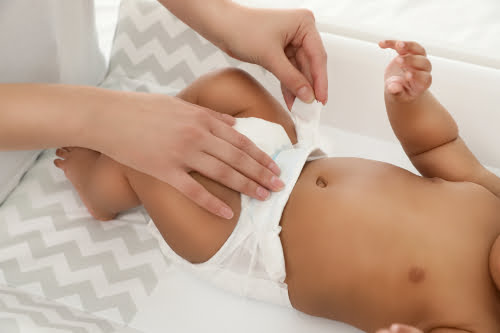
Diaper Rash
Diaper rash is usually caused by wetness and friction. Urine and stool (pee and poop) can cause even more irritation, and this leads to breakdown of the skin. Products used to clean the skin can sometimes add to the irritation.
Once the skin under the diaper becomes irritated, germs like bacteria and yeast can infect the skin and worsen the rash. In some cases, other skin conditions, like psoriasis, can be worsened or triggered by diaper rash.
Diaper rash is most common in newborns and infants, but anyone who needs to wear a diaper can develop this rash. About one-half of all babies develop diaper rash at some time during the first year or two of life. Diaper rash is most common between 9 and 12 months of age.
Diaper rash is more common when the child is having frequent bowel movements (diarrhea). An illness, a medication like an antibiotic, or a change in diet can cause changes in bowel movements.
Prevention:
- Change diapers frequently. A daily short bath in lukewarm water helps to prevent skin breakdown. Use only gentle cleansers that are fragrance-free. Avoid bubble baths.
- Using super absorbent disposable diapers keeps the skin under the diaper as dry as possible.
- Wipes:
- Cleanse the skin gently rather than scrubbing. Do not overdo it! Too much cleaning can actually irritate the skin, particularly when harsh soaps or chemicals from wipes are involved.
- Soft cloths moistened with plain water are the gentlest because they do not contain chemicals.
- If you choose packaged wipes, choose wipes that are alcohol-free, fragrance-free, and free of essential oils.
- Barrier diaper creams, pastes and ointments:
- Apply thick amounts of a diaper cream to the skin to protect the area after every diaper change. You do not need to clean off cream left on the skin if the child has not had a bowel movement.
- A cream or paste containing zinc oxide (thick and white) or a plain white petroleum jelly or ointment is best.
Treatment:
- It is important to use super absorbent disposable diapers and not cloth diapers when there is a diaper rash.
- If your doctor prescribes a medicated cream to treat the diaper rash, apply it directly to the skin after cleaning the skin gently.
- Apply a barrier cream (with zinc oxide or petroleum jelly) over the medicated cream. Use the barrier cream as many times a day as possible. You cannot use too much barrier cream. Put the cream on thick so that the urine or stool can never touch the baby’s skin.
- When you change the diaper, if the diaper cream is still there and not soiled by stool, you don’t have to wipe it all away. Simply apply more cream on top. When the cream is soiled by stool, it can be gently wiped away with mineral oil on a cotton ball followed by gently cleaning the skin with a soft cloth and warm water.
- The barrier diaper cream should be applied to the skin in a thick layer after every diaper change.
- It is best not to use packaged diaper wipes while your baby has a rash. Instead, use a soft white cloth with warm water to gently clean the skin. When changing diapers that only contain urine, simply pat the skin dry and reapply the barrier diaper cream.
- It is very important not to scrub the diaper area.

